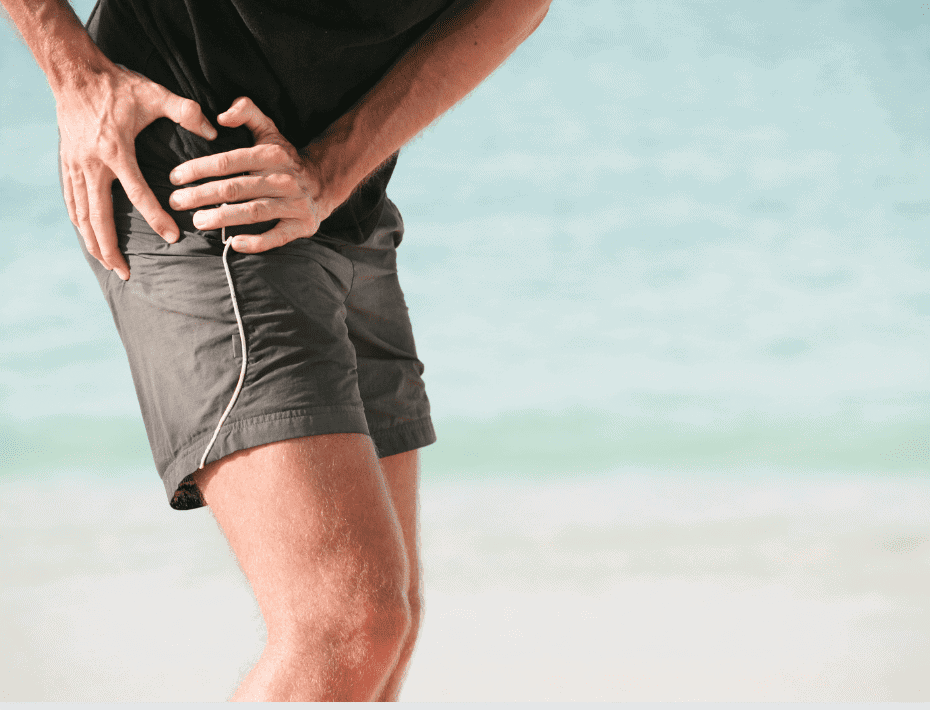Think that Hip Pain is Hip Bursitis? Think Again.
Hip bursitis, which is also referred to as trochanteric bursitis, is a condition presenting as pain on the side of the hip. The pain is usually a painful, deep ache that worsens when lying on the side, sitting, or crossing the legs. The bursa are on the side of the hip, where muscles, tendons, and ligaments also attach. The bursae are soft, jelly-like sacs that lay among the structures of the hip. Trochanteric bursitis is when those sacs get inflamed on the hip, from repeated compression. The figure below (1) illustrates a healthy bursa on the left-side of the picture, and an inflamed bursa on the right side of the picture.
Although hip bursitis is a real diagnosis and a possible cause of hip pain, it is actually over-diagnosed and not always the cause of hip pain. In fact, a Harvard Health article states:
…several other conditions can cause similar pain, and require different treatments. “Doctors often assume that pain on the outer side of the hip is due to bursitis. But 90% of the time, it’s not bursitis,” says Dr. Lauren Elson, a physiatrist with Harvard-affiliated Massachusetts General Hospital. (2)
Hip bursitis can be over-diagnosed and over-treated. Standard treatment for hip bursitis are cortisone injections, which can create temporary relief, but does not fix the underlying cause.
Our physicians at Regenexx at New Regeneration Orthopedics of Florida perform detailed examinations to identify the root cause of a problem, so the area of issue can be fixed. From our physician’s experience, they have seen that patients who come in the office with a previous diagnosis of hip bursitis still have the same pain, even after a cortisone injection, and are even worse off than before the cortisone. Cortisone can weaken the surrounding hip tissues, so can actually lead to worse issues down the road. Read on to learn other non-bursitis reasons your hip could be hurting.
3 Other Reasons Why Your Hip Could Be Hurting
Hip Tendonitis
Tendonitis is the inflammation of the tendons of the hip abductor and rotator muscles. These inflamed tendons also can develop calcific changes over time. The calcific changes in chronically inflamed hip tendons cause decreased elasticity in the tendons and can cause a deep ache over the hip. A non-operative regenerative solution for this hip pain at New Regeneration Orthopedics is commonly Platelet Rich Plasma (PRP) that is injected into the inflamed tendon.
Hip Muscle Tear
Small tears in the tendons of the hip muscles can cause pain in the outside of the hip. When the tendon has small tears, the muscles firing capacity weakens, but the repeated load of the muscle contracting on a weakened and damaged tendon leads to a deep pain and ache on the outside of the hip. We successfully treat these types of injuries with PRP or Bone Marrow Concentrate (BMAC).
Tight Muscles
Muscles in the hip and hamstrings can lead to imbalances that cause pain on the outer hip. This case of hip pain can be identified in a physical examination performed by your physician. If they identify your hip muscles are too stiff or tight, but they do not identify any tissue inflammation or damage, they may refer you to perform some simple hip stretches, or visit your physical therapist. However, this type of muscle imbalance, if left unaddressed, can develop into hip tendonitis or glute tears that would require more therapeutic interventions like PRP or BMAC.
Strategies for Beating Hip Pain
The following exercises (3) address the tight muscles of the hip. This content is not intended to be a substitute for professional medical advice, diagnosis, or treatment. Always seek the advice of your physician or another qualified health provider with any questions you may have regarding a medical condition.
Glute Rolling
- Place your foam roller on the floor and sit on it having one foot over the opposite knee in a figure 4 position.
- Roll along your buttock in a front to back motion from your lower back to the bottom of the buttock.
- Maintain your abs tight and proper lower back posture during the exercise.
- Roll for 2-3 minutes. If you feel numbness or tingling at any time, cease the exercise.
Hamstring Rolling
- Sit on a hard surface and put a lacrosse or tennis ball underneath your hamstring.
- Put some weight over the area and roll your body over the ball.
- If you find a tender spot, keep the ball in position then extend and flex your knee.
- Perform for 1 minute on each leg.
Seated Figure 4
- Sit on a chair having one foot over the opposite knee in a figure 4 position.
- Push on your knee to open the leg and straighten your back while you move your upper body forward until you feel a comfortable stretch in your buttock.
- Hold the stretch for one minute.
Hamstring Stretching
- Lie on the floor in a doorway or close to a corner of a wall.
- Place one leg up against the wall, the other is straight on the floor and your buttock is as close as possible to the door frame or wall.
- Extend the elevated leg and pull your toe down as much as possible until you feel a stretch behind your thigh.
- Hold the stretch for 2 minutes on each leg.
If you have a hip bursitis diagnosis and would like to get more answers about the root cause of your hip pain, our physicians at Regenexx at New Regeneration Orthopedics would love to perform a detailed evaluation to help identify the cause of your pain.
References:
- https://www.drandrewdutton.com/blog/hip-bone-pain/
- https://www.health.harvard.edu/pain/think-that-hip-pain-is-bursitis-think-again
- Physiotec.ca










